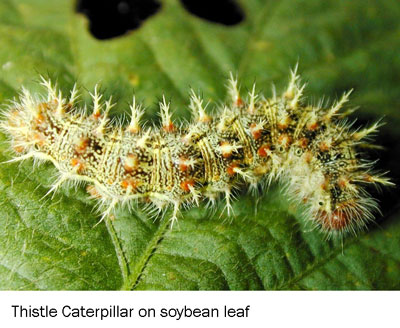
- Thistle caterpillars are named for their feeding preference on thistle or nettle, not for their spiny appearance.
- These caterpillars occasionally feed on soybeans, defoliating and webbing leaves at the top of the plant.
- Control is seldom needed but the same soybean defoliation threshold can be used as for other insects.
Background
Thistle caterpillars are named for their preference for feeding on certain species of nettle or thistle. Because these caterpillars happen to have spines on their bodies, many people believe they got their name for this reason. These caterpillars will occasionally feed on the upper leaves of soybean plants. Their defoliation and webbing together of edges of soybean leaves is unsightly but rarely is yield limiting.

Two migratory butterflies produce larvae called thistle caterpillars, the painted lady butterfly, Vanessa cardui, and the red admiral butterfly, Vanessa atalanta. These colorful butterflies are common migrants into our area, with cyclical high populations developing from time to time. These insects generally have two seasonal broods.
Description
Painted lady butterflies are medium sized (2 ½" wingspan) with wings that are mostly black, brown and orange or pink on the upper side and mottled, on the underside, with shades of brown, gray and pink. They can often be seen visiting flowers, including thistles, for nectar. The red admiral is about the same size as the painted lady butterfly, but they are black with orange or red bands across the forewings and along the rear edge of the hind wings. The forewings also have white spots. Red admirals and painted ladies are actually related, in the same genus. The larvae of these butterflies, the thistle caterpillars, are usually pale to dark colored and are spiny.
Management
Control of thistle caterpillars in soybeans is rarely necessary but may occasionally be justified with defoliation levels that are the same as for other insects. In the bloom to pod-fill stage of growth, insecticide use may be justified when there is 20-25 percent defoliation. Few insecticide labels list this insect, although many approved soybean insecticides will provide effective control. The tendency for these caterpillars to feed right at the top of soybean plants causes defoliation to be overestimated. This should be considered when scouting for these insects.
Contact your FS Crop Specialist for your agronomic information.
